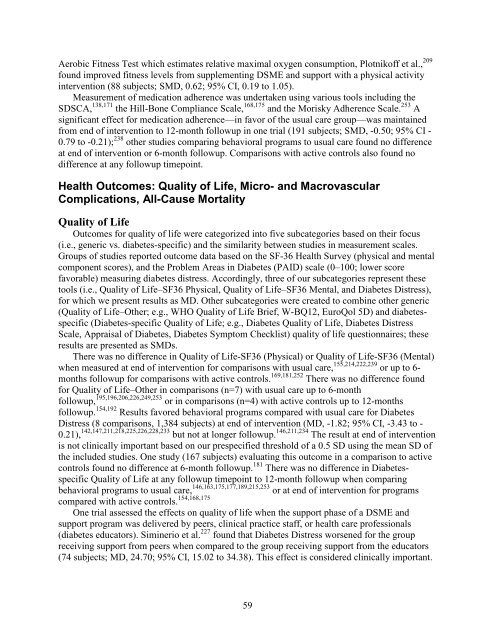Behavioral Programs for Diabetes Mellitus
diabetes-behavior-programs-report-150924
diabetes-behavior-programs-report-150924
- No tags were found...
Create successful ePaper yourself
Turn your PDF publications into a flip-book with our unique Google optimized e-Paper software.
Aerobic Fitness Test which estimates relative maximal oxygen consumption, Plotnikoff et al., 209<br />
found improved fitness levels from supplementing DSME and support with a physical activity<br />
intervention (88 subjects; SMD, 0.62; 95% CI, 0.19 to 1.05).<br />
Measurement of medication adherence was undertaken using various tools including the<br />
SDSCA, 138,171 the Hill-Bone Compliance Scale, 168,175 and the Morisky Adherence Scale. 253 A<br />
significant effect <strong>for</strong> medication adherence—in favor of the usual care group—was maintained<br />
from end of intervention to 12-month followup in one trial (191 subjects; SMD, -0.50; 95% CI -<br />
0.79 to -0.21); 238 other studies comparing behavioral programs to usual care found no difference<br />
at end of intervention or 6-month followup. Comparisons with active controls also found no<br />
difference at any followup timepoint.<br />
Health Outcomes: Quality of Life, Micro- and Macrovascular<br />
Complications, All-Cause Mortality<br />
Quality of Life<br />
Outcomes <strong>for</strong> quality of life were categorized into five subcategories based on their focus<br />
(i.e., generic vs. diabetes-specific) and the similarity between studies in measurement scales.<br />
Groups of studies reported outcome data based on the SF-36 Health Survey (physical and mental<br />
component scores), and the Problem Areas in <strong>Diabetes</strong> (PAID) scale (0–100; lower score<br />
favorable) measuring diabetes distress. Accordingly, three of our subcategories represent these<br />
tools (i.e., Quality of Life–SF36 Physical, Quality of Life–SF36 Mental, and <strong>Diabetes</strong> Distress),<br />
<strong>for</strong> which we present results as MD. Other subcategories were created to combine other generic<br />
(Quality of Life–Other; e.g., WHO Quality of Life Brief, W-BQ12, EuroQol 5D) and diabetesspecific<br />
(<strong>Diabetes</strong>-specific Quality of Life; e.g., <strong>Diabetes</strong> Quality of Life, <strong>Diabetes</strong> Distress<br />
Scale, Appraisal of <strong>Diabetes</strong>, <strong>Diabetes</strong> Symptom Checklist) quality of life questionnaires; these<br />
results are presented as SMDs.<br />
There was no difference in Quality of Life-SF36 (Physical) or Quality of Life-SF36 (Mental)<br />
when measured at end of intervention <strong>for</strong> comparisons with usual care, 155,214,222,239 or up to 6-<br />
months followup <strong>for</strong> comparisons with active controls. 169,181,252 There was no difference found<br />
<strong>for</strong> Quality of Life–Other in comparisons (n=7) with usual care up to 6-month<br />
followup, 195,196,206,226,249,253 or in comparisons (n=4) with active controls up to 12-months<br />
followup. 154,192 Results favored behavioral programs compared with usual care <strong>for</strong> <strong>Diabetes</strong><br />
Distress (8 comparisons, 1,384 subjects) at end of intervention (MD, -1.82; 95% CI, -3.43 to -<br />
0.21), 142,147,211,218,225,226,228,233 but not at longer followup. 146,211,234 The result at end of intervention<br />
is not clinically important based on our prespecified threshold of a 0.5 SD using the mean SD of<br />
the included studies. One study (167 subjects) evaluating this outcome in a comparison to active<br />
controls found no difference at 6-month followup. 181 There was no difference in <strong>Diabetes</strong>specific<br />
Quality of Life at any followup timepoint to 12-month followup when comparing<br />
behavioral programs to usual care, 146,163,175,177,189,215,253 or at end of intervention <strong>for</strong> programs<br />
compared with active controls. 154,168,175<br />
One trial assessed the effects on quality of life when the support phase of a DSME and<br />
support program was delivered by peers, clinical practice staff, or health care professionals<br />
(diabetes educators). Siminerio et al. 227 found that <strong>Diabetes</strong> Distress worsened <strong>for</strong> the group<br />
receiving support from peers when compared to the group receiving support from the educators<br />
(74 subjects; MD, 24.70; 95% CI, 15.02 to 34.38). This effect is considered clinically important.<br />
59


